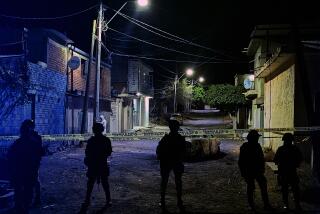Mitterrand Leaves Paris for New Caledonia, Faces Anger of White Residents
- Share via
PARIS — President Francois Mitterrand left Paris on Thursday night on a flight of almost 24 hours to the South Pacific islands of New Caledonia, but whites in that racially troubled French territory were described as angry about his impending arrival.
White political leaders did not call for any anti-Mitterrand demonstration, which would be against the law in the present state of emergency there. But anonymous tracts circulated throughout Noumea, the white-dominated capital, urging a massive display of the French flag during Mitterrand’s visit and a silent pouring into the streets of all those opposed to any form of independence.
Because Mitterrand announced that he was flying there to support Paris’ proposal for an independent New Caledonian state associated with France, the whites, who oppose any kind of independence, do not see any use in his visit.
One white businessman in Noumea, for example, told the French news agency Agence France-Press, “It outrages me that he is coming here. We don’t expect anything from him.” A white teacher said, “If he is coming with preconceived ideas, it is hardly worth the trouble to make the trip.”
Kanaks May Be Amenable Although the main political party of the Kanaks, as New Caledonia’s native Melanesians are known, is demanding total independence rather than the limited form now offered by France, the party leaders have not commented on the Mitterrand visit. There has been a hardening of the Kanak position recently because of the killing of one of their leaders last week by French gendarmes, but many French analysts believe that they are more willing than the whites to accept the French proposals.
Mitterrand is scheduled to arrive in Noumea sometime Saturday morning (New Caledonia time) and stay only 24 hours. No official program was released, but he is expected to tour the countryside by helicopter in the morning and then meet with political leaders of the various racial communities in the afternoon.
The French territory, an island chain east of Australia, has been tense and sometimes violent for two months in a struggle between the Kanaks and the whites over the future of the islands. The Kanaks, the original native population, total a little more than 60,000 people, the largest number but less than a majority. The whites, many descended from French people exiled there in the 19th Century, have a population of a little more than 50,000. Others from the Pacific and Asia total around 30,000.
There was little doubt that Mitterrand’s decision to go to New Caledonia surprised many of his aides. It was not even clear that he had informed Edgard Pisani, the French government representative in New Caledonia, of his plans.
It was Pisani who had first made the offer of New Caledonian independence in association with France. Under Pisani’s proposal, this form of independence, if approved by a referendum in July, would take effect next Jan. 1.
Mitterrand told a national television audience Wednesday night that he was flying to New Caledonia to support the Pisani plan as the only way to balance the differences of the antagonistic racial groups and prevent violence.
The increasing violence, which has claimed the lives of at least 18 people, mostly Kanaks, in the last two months, has made it more and more difficult for the whites and Kanaks to compromise their differences. In fact, some news reports from New Caledonia indicate that the Pisani plan is practically dead and that it will be nearly impossible for Mitterrand to resurrect it.
In Noumea, Pisani met with Dick Ukeiwe, the leader of the territorial government, and with Jean-Marie Tjibaou, the main Kanak leader, to discuss the Mitterrand visit. It was Tjibaou’s reaction that was most sought afterwards, but he refused to comment.
More to Read
Sign up for Essential California
The most important California stories and recommendations in your inbox every morning.
You may occasionally receive promotional content from the Los Angeles Times.












